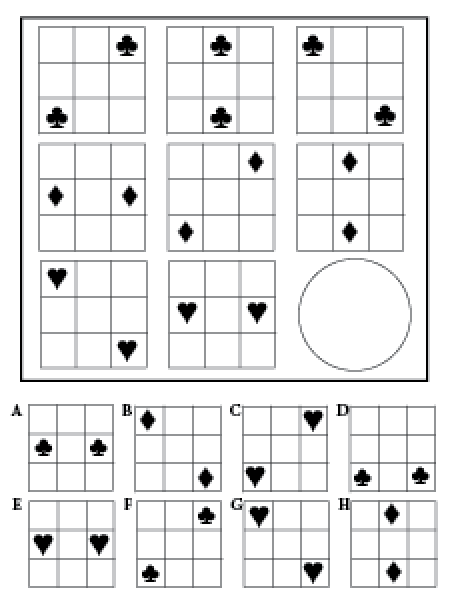In 1936, John C. Raven attempted to address the criticism that the prevailing IQ tests were culturally dependent, because people from educationally deprived environments may not have been exposed to an expansive vocabulary or knowledge specific to a particular culture. To address this criticism, and make tests of intelligence independent of knowledge, he developed the prototype for multiple choice tests known today as the Raven’s Progressive Matrices.
What does a Raven’s Progressive Matrices IQ Test Look Like?
While there are many different IQ tests, the Raven’s Progressive Matrices have the most widespread usage because they are not “culture-loaded.” That is, they are purely visual, language-independent, and free of knowledge favoring any culture. Each test usually consists of between 48 and 60 items, presented in order of increasing difficulty and is often time-limited to about 40 minutes. A sample of the kind of items that appear on these tests is given below.
Sample Item: Select the option, A through H, that belongs in the circle below to complete the pattern. (Try this before reading ahead.)

Typically, an item consists of an array of 3 × 3 grids, called matrices, arranged in 3 rows and 3 columns. As you scan the 3 matrices from left to right in a particular row, you are asked to determine how each matrix is derived from the one on its left. Sometimes, there will also be a relationship among matrices in the same column, in which case you are required to ascertain how each matrix is derived from the one above it. Answering an item correctly involves choosing the matrix or matrices that complete the pattern or patterns evident within the progression from left to right and/or top to bottom.
Answer to Sample Item 1
As we move from left to right along the top row of 3 × 3 matrices, the line joining the “clubs” rotates by 45˚ counterclockwise. Similarly, as we move from left to right along the middle row of 3 × 3 matrices, the line joining the “diamonds” rotates by 45˚ counterclockwise.
Also, as we move from left to right along the bottom row of 3 × 3 matrices, the line joining the “hearts” rotates by 45˚ counterclockwise.
Moving from top to bottom in each column of matrices, we observe that the line joining the icons rotates by 45˚ clockwise and the symbols change from clubs to diamonds to hearts. Taking into account both the angular and symbol changes, answer C is the only matrix that continues the patterns from left to right and top to bottom in the array of 3 × 3 matrices.
What the Test Measures
Identifying the patterns in Sample Item 1 is something most people can do, so increasingly more difficult patterns appear in successive items. A person’s innate problem solving ability and ability to identify complex patterns determines how many items they will be able to answer successfully before the problems become too complex for them. In this way, the Ravens Progressive Matrices tests are designed to be independent of prior knowledge and consequently culture-free. They measure the component of g (general intelligence) called fluid intelligence. The other component of g is crystallized intelligence, that is closely connected to accumulated knowledge.
Even though ravens and other corvids are found to be highly intelligent, there is no known case of a raven, except for John, who has successfully completed an item like the one above.
